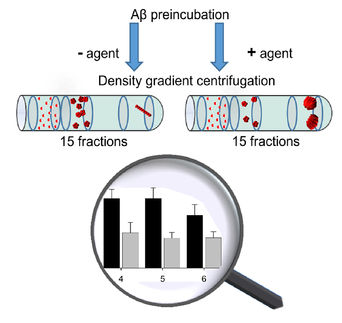Therapeutic screening for Alzheimer’s disease
Scientists in Canada and the United States have developed a chip sensor for monitoring how drug candidates alter amyloid-β peptide aggregation that they hope could be used to find new treatments for Alzheimer’s disease.
Research into Alzheimer’s disease has shown that the self-aggregation of the amyloid-β (Aβ) peptide plays a vital role in the development of the disease. A number of techniques have been investigated to study Aβ aggregation, including acoustic wave sensors, electrochemistry and atomic force microscopy.
Now, for the first time, researchers have used an LED-interferometric reflectance imaging sensor (LED-IRIS) to look at the interaction of Aβ peptide with small drug candidates. The sensor uses a Si/SiO2 layered substrate as the sensing surface, which is spotted with Aβ peptide ‘seeds’ using a desktop spotting unit. The sensing surface is incubated with Aβ oligomer solution and drug candidates, which results in differing areas of Aβ peptide aggregation. The sensor monitors this aggregation by detecting optical path length changes. The scientists used green tea polyphenol epigallocatechin-3-gallate and zinc, which are already known to inhibit and promote Aβ peptide aggregation respectively, as model modulators to test the system and show it works.
Kagan Kerman at the University of Toronto at Scarborough, who led the research, said: “We have successfully demonstrated a novel method for high throughput screening of small molecules modulating Aβ growth and it provides a promising platform to facilitate therapeutics discovery for Alzheimer’s disease.”
Most read news
Original publication
Organizations
Other news from the department science

Get the analytics and lab tech industry in your inbox
By submitting this form you agree that LUMITOS AG will send you the newsletter(s) selected above by email. Your data will not be passed on to third parties. Your data will be stored and processed in accordance with our data protection regulations. LUMITOS may contact you by email for the purpose of advertising or market and opinion surveys. You can revoke your consent at any time without giving reasons to LUMITOS AG, Ernst-Augustin-Str. 2, 12489 Berlin, Germany or by e-mail at revoke@lumitos.com with effect for the future. In addition, each email contains a link to unsubscribe from the corresponding newsletter.
























































